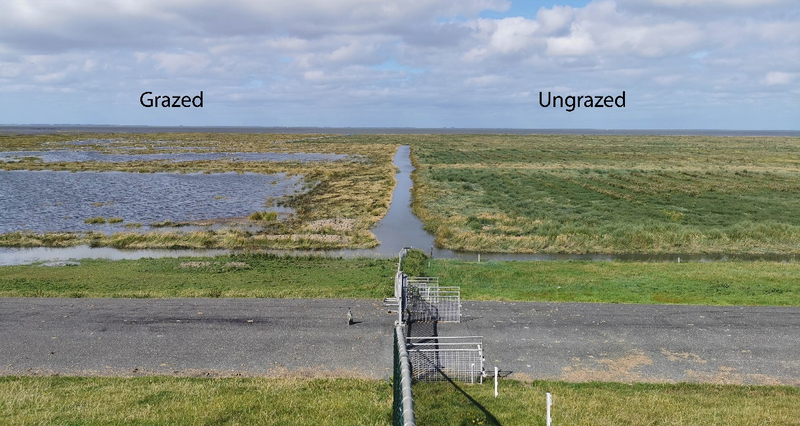Kelly Elschot1*, Martin Baptist1, Marinka van Puijenbroek1^
1Wageningen Marine Research
*corresponding author:
Introduction
A global concern for coastal ecosystems is the predicted rise in sea-level for which salt marshes must keep pace by increasing in surface elevation sufficiently. Variables that control the marsh accretion rates need to be identified to predict the adaptability of marshes to future sea-level rise. Many European marshes are grazed by livestock to maintain plant diversity. These heavy grazers can biocompact the marsh soil, a process often underestimated in studies assessing the long-term survival of salt marshes.
Methods
We measured marsh accretion rates and vegetation composition for thirteen years in the field in neighbouring grazed and non-grazed marshes at Holwerd, the Netherlands. The most important factors controlling current marsh accretion rates were identified using a statistical model and provided the input for mathematical model to study future accretion rates of grazed and non-grazed salt marshes up to 2100 under three sea level rise and sediment supply scenario's.
Results
We found that trampling by grazing cattle significantly reduced marsh accretion rates from 11.9 mm yr-1 in the non-grazed marsh to 3.6 mm yr-1 in the grazed marsh. Next to biocompaction by livestock, precipitation deficit and a period of extreme drought resulted in extra compaction of the marsh. Our model results showed that cattle presence had a negative impact on the future adaptability of salt marshes to grow vertically for rising sea levels. Biocompaction reduced the total accretion of the marsh by 42% if the current linear SLR does not accelerate. For an accelerating and high SLR to 109 cm +NAP in 2100, biocompaction reduced total accretion by 12% and the grazed marsh can no longer outcompete the rise in sea level from around 2050 onwards, compared to the non-grazed marsh. The grazed marsh will slowly drown but this will not lead to a significant change in vegetation composition yet. For an extreme SLR to 195 cm +NAP in 2100 the accretion rate in both the grazed and non-grazed marshes cannot keep pace with the rise in sea level and the marsh vegetation is expected to show regression to plants typical for a low marsh. A reduction in sediment supply will aggravate the effects of SLR and may result in highly increasing inundation frequencies and subsequent disappearance of the marsh vegetation.

Figure 1: Grazing can reduce salt marsh accretion and thereby accelerate drowning with sea level rise. (image courtesy: M. van Puijenbroek).
I. Surname1*, F.N. Another-Surname2 , Y. Next-Surname2
1 University Name, Country; 2 Organization Name, Country
* Corresponding author: mail.name@organization.org


